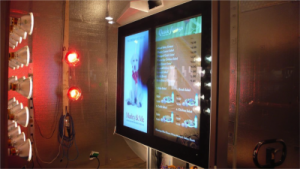Digital signage is an exquisite instrument for mass communication, but once unboxed and placed in the open, it turns into a fragile instrument. There are many threats to the safety of your digital technology, be it indoors or outside. Factors like harsh weather conditions, sunlight, rainfall, dust and, of course, people are to be watched out for. Protect digital signage from all these elements, and ensure your investment doesn’t fall to pieces. First, let’s take a look at the threats to digital signage in the outdoors.
1. The wrath of nature
Regretfully, if your area gets a direct visit from a tornado or a hurricane, there really isn’t much you can do to protect digital signage outdoors other than take it inside if physically possible and you have enough time to prepare. Your own safety should always have priority. During other milder forces of nature however, like heavy rainfall, winds and storms, physical protection will certainly help. Look for digital signage casing, screen protection, etc.
Additionally, shutting off your digital signage during harsh weather conditions can prevent damage caused by intense moisture or a cover of dust brought by the heavy winds.
2. The worst of humanity
Outdoor digital signage needs protection from the elements of nature, but no element is as threatening as the presence of a human. If your digital signage is not attended by a staff member, you must make sure it can’t be stolen. There are other ways people can threaten your technology, but stealing is the worst.
Ensure your digital signage can’t be removed, be it carefully or forcefully. In most cases, if your displays aren’t touchscreens, there is no need for them to be within hand’s reach of your audience. Place them in your store window, or if they must be in the open, make sure they’re placed high, beyond reach. Afterall, the eye level is where the attention is.
Additional methods for keeping bad people at bay include using proximity alarms, device trackers, screen protectors and more!
Examine the physical properties of your digital signage
In what ways can a user interact with your digital signage?
If you’re using a touchscreen to provide interaction, there is no need to allow users to connect their phones to it. For example, if your display or player has Bluetooth capabilities, make sure they’re turned off, unless you’re using them. This is only one of many ways someone might interact with your signage in a way you don’t want them to.
Is your digital signage content fed through a USB port? If so, consider the possibility of someone walking up and and replacing your USB drive with their own?
Limit the access to your system
Examine which other loopholes of unwanted interaction exist for your digital signage and shut them off. A good test is to try to access your content through unauthorized means yourself. If you successfully change your content without having to apply your admin authority, your software is compromised.
Ideally, the user should not be able to access anything other than what you want them to. Make sure you system has a password in place and can’t be overridden in any way. Of course, no defense is impenetrable, but the vast majority of people with bad intentions can be stopped with a few simple countermeasures.
Protect digital signage indoors too!
Indoors, there aren’t as many physical dangers as there are outdoors, but they certainly do exist.
Let’s talk about our fellow humans again, and move them to an indoor environment. If people are looking to steal you digital signage indoors, a massive display will already prove a challenge just by size, especially when mounted. However, smaller displays and tablet devices are easier target. This is why digital signage tablets and displays are either mounted on walls, screwed on an attachment or part of heavy stands as kiosks.
Now that the cleptomaniacs are fought off, let’s talk about other threats for indoor digital signage.
3. Flying too close to the sun
Short of natural disasters, sunlight is the one power of nature which penetrates the indoors. UV damage can be quite threatening to LCD displays, leading to isotopic failure. In a nutshell, this means your displays will gradually turn black through prolonged exposure to sunlight.
Isotopic failure can’t be fixed, and if it occurs, you will need to get a new display to turn the light back on.
A solution is to keep the display in the shade, or to get commercial displays specifically designed to prevent sunlight glare. LED displays are a great option for this, which is why they’re often used outdoors. If there is plenty of exposure to sunlight, they are certainly something for the indoors as well.
Be careful, though. Certain displays designed to deflect the glare from sunlight can’t be seen by people who wear polarized sunglasses. As polarized eyewear blocks sunlight, it may do the same to the display image. You may have noticed this when looking at some smartphone displays through polarized sunglasses.
4. It’s getting hot in here
High temperatures can cause damage, not only to displays but to players as well. Now you may be thinking players aren’t usually exposed to sunlight. You’re right! They are usually tucked away from view, but exactly that can be the problem.
Digital signage players generate heat, but if they’re in tight spaces with no air circulation, they can’t cool down. Temperatures keep rising, and the player performance drops. Resolve this issue by changing the placement of players, or if that isn’t an options, get players with a cooling system.
Digital signage faces threats on many fronts, as we’ve seen. Starting from long term exposure to the elements of nature, or short term exposure to bad people, it needs to be protected. Make sure you protect digital signage with these guidelines, and you are guaranteed many years of optimal use and the best rewards this amazing tool has to offer.











